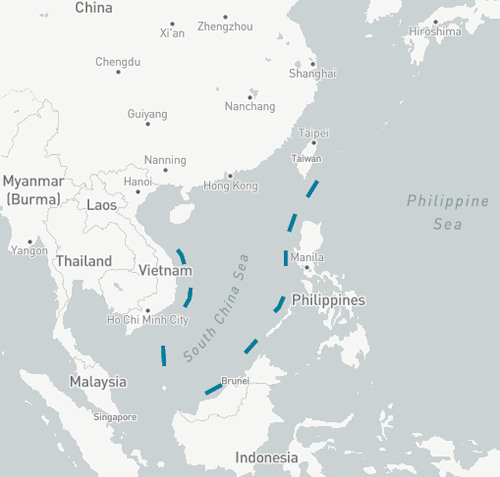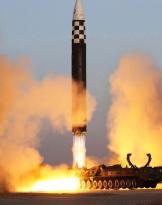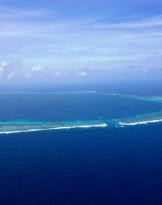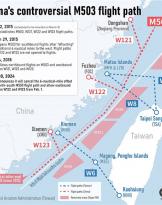It is now known that Taiwan is considered by China as a secessionist province, which will have to return, sooner or later, to the orbit of the motherland if necessary also with the use of force. A will reaffirmed in 2005, with the anti-secession law and reaffirmed in 2018 through the statements of the (just re-elected) Chinese president Xi Jinping who asserted that history would have inflicted exemplary punishment on all those who had harmed the unity of the country.
To this end, Beijing pursues an intimidating policy aimed at dissuading the United States - and other actors in the region - from recognizing Taiwan.
In support of China's intimidation policy, the Navy Air Force (PLANAF) is also undergoing a major restructuring, with the assignment of long-range maritime patrol aircraft, radar and embarked. The land-based naval aircraft is booming, as a pillar of the A2 / AD (Anti-Access / Area Denial) device, through the deployment of over 200 JH-7 fighter-bombers (photo), capable of also developing SEAD (Suppression of Enemy Air Defences), equipped with disturbance pods and heavy anti-radiation missiles YJ-91 (Chinese version of the Russian Kh-31), and strategic bombers H-6.
Taiwan, due to its position as a "hinge" between the North China Sea and the South China Sea, is the natural continuation of the defensive system of Japan to the north, and with that of the Philippines to the south: states that are close allies of the United States. Therefore, it constitutes a fundamental asset of the American system of containment of China within the first chain of islands, or the island system that connects Japan with Vietnam, skirting Taiwan, the Philippines, Brunei and Malaysia.

Taiwan has not only a geopolitical relevance but, being the 21a largest economy in the world, it has a very important influence on economic prosperity and stability in the Indo-Pacific region. In particular, Taiwan's semiconductor industry occupies a pivotal position in international supply chains. The industry actively reduces the use of energy resources in its production processes by developing new technologies and new models. Through ever-evolving innovations in semiconductors, it has developed numerous intelligent applications for electronic devices and promoted global energy savings.
Although not recognized by most states, Taiwan is keen to cooperate with international partners to achieve, in compliance with Paris agreements, to an ecological transition that will lead the island to emit zero emissions harmful to the environment by 2050, announced by President Tsai Ing-wen, in the Earth Day of 22 April 2021.
In this regard, Taiwan is pursuing substantial climate action and vigorously leading the energy transition. As of May 2022, the cumulative installed renewable energy capacity had reached 12,3 GW, a significant increase of 60% compared to 2016. From 2005 to 2020, Taiwan's GDP grew by 79%. In the same period, the intensity of greenhouse gas emissions decreased by 45%, showing that economic growth has been decoupled from greenhouse gas emissions.
The Taiwanese strategy to achieve the goal is based on the parallel foundations of governance regarding research and technological development (R&D) and climate legislation, and are complemented by 12 key strategies. These are wind and solar energy; hydrogen; innovative energy; energy supply and storage systems; energy saving and efficiency; carbon capture, use and storage; carbon-free and electric vehicles; resource recycling and zero waste; natural carbon sinks; green lifestyles; green finance; and just transition.
By integrating intra-government resources, Taiwan will develop a step-by-step action plan to achieve its goals.
Taiwan will focus on five macro areas: sustainable energy, low carbon emissions, circularity, carbon negativity and social sciences. The Greenhouse Gas Reduction and Management Act is undergoing modification and will be renamed Climate Change Response Act. These amendments will make zero net emissions by 2050 a national long-term reduction target, improve the effectiveness of climate governance, add a chapter on climate change adaptation, strengthen information disclosure and public participation, and introduce a carbon pricing mechanism. The act will provide economic incentives to reduce emissions, drive green and low-carbon growth, and help complete the foundations of national climate legislation and governance.
Taiwan's long-term vision for 2050 is to make the transition to zero emissions the new driving force of national development. By creating competitive, circular, sustainable, resilient and secure transition strategies and governance foundations, Taiwan will stimulate economic growth, encourage private investment, create green jobs, promote energy independence and improve social well-being.
Despite the more or less veiled threats expressed in the last congress of the Chinese Communist Party by President Xi Jinping, Taiwan looks to the future, free, independent and environmentally sustainable.
Photo: Ministry of National Defense of the People's Republic of China / web












